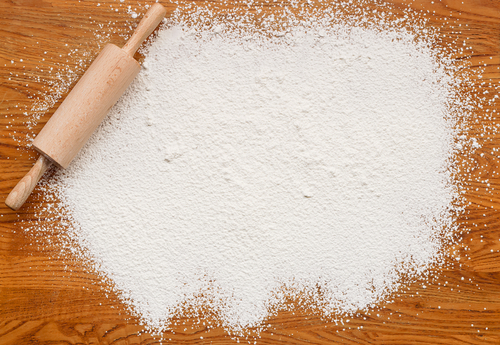Short answer
Bleached flour can be bad for you. The process and treatment composition uses many chemicals that can have negative effects on your body. It can also create some rather unpleasant by-products.
Recommended Alternative
Long answer
The first question that any sane person would probably ask is why bleached flour in the first place? The answer is fairly simple: freshly milled flour has more of a yellow consistency and only turns white over time. This aging process usually takes one or two months and can be fairly unpredictable. Manufacturers use bleach to achieve a consistent whiteness throughout their flour, almost immediately after milling. This does have its drawback, however. Naturally aged flour has far superior baking qualities compared to that of freshly milled flour, as the gluten proteins are formed in a much stronger way.
The main reason why bleached flour can be considered bad for you is the types of chemicals that are used in the bleaching process. It's not just about aesthetics - they also have to improve its baking quality. Industrial millers use a range of different bleaching agents in their product that all come with their own particular risks. The list is pretty exhaustive but some of the most common agents used are:
Azodicarbonamide - Banned throughout most of Europe and Australia, it is believed that azodicarbonamide is a potential cause of asthma. It was also found to cause cancer in lab rats. The Food and Drug Administration (FDA) in the United States has not banned it because they believe that it is not being heavily used, though there is some speculation that Azodicarbonamide is used in the production of bread products in some fast food restaurants.
Chlorine Dioxide - As well as eradicating any vitamin E from the flour, the most alarming aspect of chlorine dioxide is the by-product it forms known as alloxan. Alloxan is a chemical compound that is commonly used in laboratories to inflict diabetes on rats and mice for research. This has given rise to the very real possibility that excess exposure to alloxan could increase the risk of developing type 2 diabetes.
Benzoyl Peroxide - Whilst deemed safe in restricted quantities by food regulation authorities, benzoyl peroxide is not without its problems. During production, the chemical is converted into benzoic acid, which can cause minor stomach irritation for those who already suffer from digestive problems or weak constitution.
While other bleaching agents may or may not be used, there is one concern that is universal throughout all bleached flours: So many nutrients are destroyed that, when combined with the potential side effects of bleaching agents mentioned above, it doesn't seem worth consuming. Evidence suggests that bleached flour destroys:
- 50% of unsaturated fat
- Virtually all vitamin E
- 50% calcium
- 70% phosphorus
- Virtually all magnesium
- 80% iron
So, to wrap things up:
While consuming bleached flour sparingly may not do any immediate harm, long-term consumption can result in many unwanted side effects. Adding chemicals to a natural product is almost always going to have little benefit to your health. We highly recommend going with an unbleached variety whenever possible. A whole wheat version like King Arthur's is even better, and will actually include a host of health benefits.
Possible short-term side effects
- stomach irritation
- allergic reaction
Possible long-term side effects
- asthma
- type 2 diabetes
- cancer
- other effects depending on bleaching agents used
Ingredients to be aware of
- benzoyl peroxide
- calcium peroxide
- nitrogen dioxide
- chlorine
- chlorine dioxide
- azodicarbonamide

Benefits
- flour more aesthetically pleasing
Our Wellness Pick (what is this?)
King Arthur Flour
- Organic quality
- Unbleached flour
- All-purpose use
- Non-GMO verified
- Chemical-free
 Approved by
Approved by 















